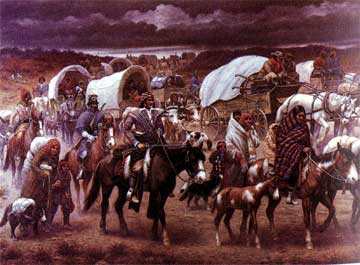
On the Trail of Tears
The Indians in the South were constantly under pressure from white settlers. Only the federal government had the ability to protect the Indians. President Jackson removed that federal protection. He then proceeded to pass the Indian Removal Act to force the Native American population to move West of the Mississippi.
Jackson’s views in favor of the removal of Indians to the west were well known before he was elected. His position on this matter was one of the main reasons for his support in the South. The major issue focused on determining the future of “The Five ‘Civilized Tribes’” (the Cherokee, Creek, Choctaw, Chickasaw, and Seminole). Through a treaty agreement, these tribes occupied large areas of Georgia, Alabama, parts of Tennessee, North Carolina, and Florida. In 1822, the federal government commissioned geographer Jedidiah Morse to survey the Native Americans. He reported on the tremendous transformation these tribes had undergone. They lived in villages, farmed the land, and practiced animal husbandry in the same way as their white neighbors. Large numbers of Native Americans had even converted to Christianity, thanks to the efforts of Christian missionaries who had established schools there.
Despite the major lifestyle changes of the Native Americans, the white settlers in the states remained envious and wanted the lands the Indians occupied for themselves. The states insisted they had rights to the lands the Indians inhabited and asserted that the treaties granting the Native Americans any land were to be ignored. The economic success of the Indians worked against what the white settlers had hoped for, as the newly prosperous Indians had no need to sell their land and thus had no incentive to do so.
Georgia was the most vigorous in taking actions against the Native Americans. During the Adams administration, Georgia did whatever it could to push out the Cherokee and Creek nations. President Adams vigorously objected to Georgia's actions and often called in federal troops to protect the Native Americans. However, Georgia was determined to continue acting against the Indians. With the election of Jackson, Georgia believed, rightly, it would have a green light. In December 1828, the Georgia legislature passed a law stating that starting in 1830, Georgian law would be imposed on the Indian areas. The Georgians claimed (while ignoring the treaties signed between the US government and the Indians) that the Indians were just “tenants at will.” Once the Jackson administration took office, Secretary of War Eaton ordered the withdrawal of federal troops. Without the support of federal troops, the Native Americans were left to the mercy of the Georgians.
President Jackson was not satisfied with taking just a passive role regarding the Indians. Instead, Jackson wanted to pass his own “Indian Removal Act.” This act would "voluntarily" remove the Native Americans from their lands and transfer them to lands in the West. While the law claimed the removal would be “voluntary,” that was merely a technicality. Everyone believed that once the Indian Removal Act was passed, there would be no way to stop the removal of the Indians. Some thought it important that the act at least mandate compensation for the Indians. Others reluctantly supported the legislation, believing it was better for the Indians to be removed under federal law than by states in defilement of federal law. Despite Jackson’s popularity, he had a hard time passing the Indian Removal Act. The Act was not popular in the North, and Christian missionaries were vocal opponents. Opponents considered the Indian Removal Act immoral and a repudiation of years of treaties.
President Adams called the removal “a perpetual harrow upon my feelings.” As a result of the intense opposition to the Act, it passed by only two votes in the House of Representatives, and only after the President put pressure on Pennsylvania Democrats to change their votes and support the measure.
After the bill passed, the government began with the Choctaws. It cost $5 million to move the first Indians, despite Jackson’s promise that it would cost only $2 million to move all of the Native tribes. Once the Choctaws had been moved, Jackson turned to the other tribes, placing as much pressure as he could on them. He cut off funding for the missionary schools and publicly stated that he would ignore all existing treaty responsibilities of the US government. The Cherokees then decided to turn to the courts for protection. The first lawsuit was "Cherokee Nation v. Georgia." The justices in this case decided to sidestep the issues by ruling on procedural matters, thus avoiding a ruling the court feared would put it in a confrontation with the Executive branch. However, the court could not avoid the issue when it took the case of "Worcester v. Georgia." In that case, the state of Georgia had imprisoned two missionaries to pressure them to support the Removal Act. These missionaries were arrested on Indian lands and appealed their imprisonment to the Supreme Court. In this case, John Marshall, writing for the court, stated that: “the Cherokees were protected within their lands, and in which the law of Georgia can have no right to enter, but with the assent of the Cherokees.” The court had no way to enforce its decision. Jackson chose to ignore it completely.
This is how one of the most woeful acts in American history took shape: the forced removal of tens of thousands of Native Americans who were living their lives in lands granted to them just a generation earlier by the American government.
 >
>